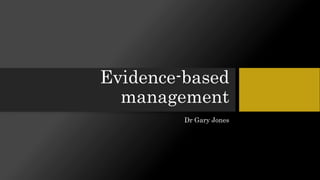
LeanIn Jersey 27 Feb 2019
- 2. Hello Dr Gary Jones Former senior leader in a further education college Blogger www.garyrjones.com/blog Speaker Author @DrGaryJones jones.gary@gmail.com 2
- 3. By the end of this session • Defined the term ‘evidence-based management’ • Explained why we need evidence-based management • Looked at what needs to be done to make EBMgt work • If you have been interested in what you have heard and seen, suggested some next steps 3
- 4. 4
- 5. 5
- 6. 6
- 7. Why we need evidence-based management? • To make better decisions • To protect us from ‘management fads’ • To help us navigate our own ‘bounded rationality’ and cognitive biases 7
- 8. Who do you work for ? 8
- 9. 9
- 10. Management fads • Emotional Intelligence • Six Sigma • Business Process Re- engineering • Management by walking about • Core competency • There is no “I” in team • Embracing mistakes • Fun by fiat • Matrix Management • Authentic Leadership 10
- 11. 11
- 12. 12
- 13. 13
- 14. How to spot a management fad/fashion • Simple, straightforward • Promising results • Universal • Step-down capability • In tune with zeitgeist • Novel, not radical • Legitimacy via gurus and star examples • Lively, entertaining 14 MILLER, D., HARTWICK, J. & LE BRETON-MILLER, I. 2004. How to detect a management fad—and distinguish it from a classic. Business Horizons, 47, 7-16.
- 15. What to do when faced with a management guru • What evidence is there that the new approach can provide productive results. Are arguments based on solid evidence from lots of organisations followed over time? • Has the approach worked in organisations similar to our own that face similar challenges? • Is the approach relevant to the priorities and strategies relevant to our organisation? • Is the advice specific enough to be implemented? Do we have enough information about implementation challenges and how to meet them? • Is the advice practical for our school given our capabilities and resources? • Can we reasonably assess the costs and prospective rewards (Amended from (Miller et al., 2004) pp 14-15 15
- 16. Activity • In the last year, what new management process have been introduced into your organisation ? • Before the decision was made to introduce the new process, what evidence was made available to show that the process actually worked • Any other observations 16
- 17. 17
- 18. 18
- 19. 19
- 20. Three cognitive biases • Confirmation bias • Halo effect • Anchoring bias 20
- 22. 22
- 23. 23
- 24. 24
- 26. How to mitigate cognitive biases • Educate yourself about cognitive biases • Reflect on your past decision-making • Seek out information from a range of sources 26
- 27. 27
- 28. 28
- 29. 29
- 30. Thing One • That the organization is a learning organization. This means that leaders: • Understand the nature of evidence-based practice, • Are committed to developing a learning focussed, evidence-centric culture and, • Can develop networks that help to find and build both evidence and skill in using it. 30
- 31. Thing Two • That staff have developed the knowledge and skills to be change agents. This means employees: • Have a level of self-efficacy or have the self-belief and confidence that they have the knowledge, capacity, and capability to engage productively in evidence-based practice, • They also need to have the ‘analytic competence’ and tools of critical thinking and, • The cognitive and other tools to productively participate in the process. 31
- 32. Advice for prospective evidence-based managers 32
- 33. 33
- 34. Want to know more about evidence-based management 34
- 35. 35
- 36. 36
- 37. For more information? Dr Gary Jones www.garyrjones.com/blog @DrGaryJones jones.gary@gmail.com 37